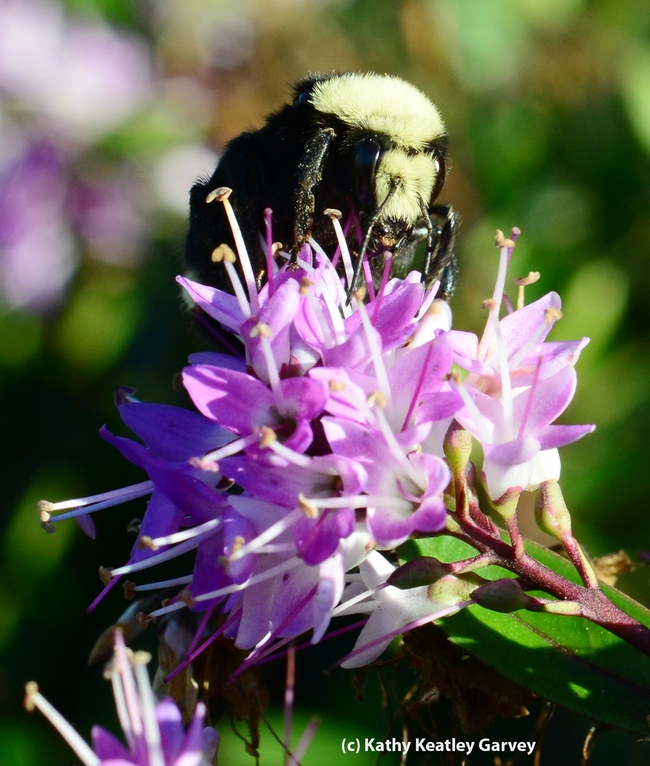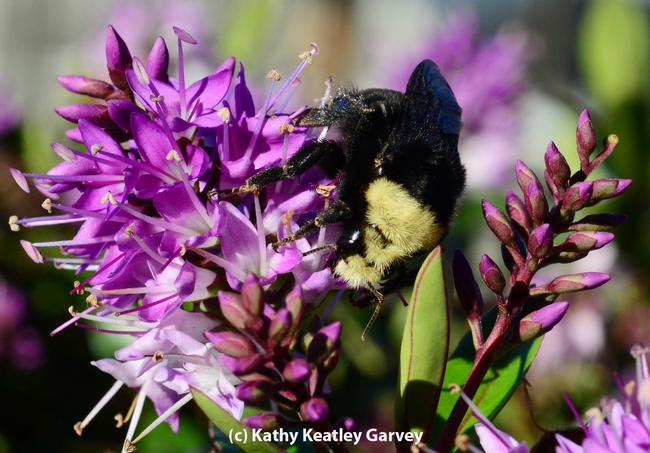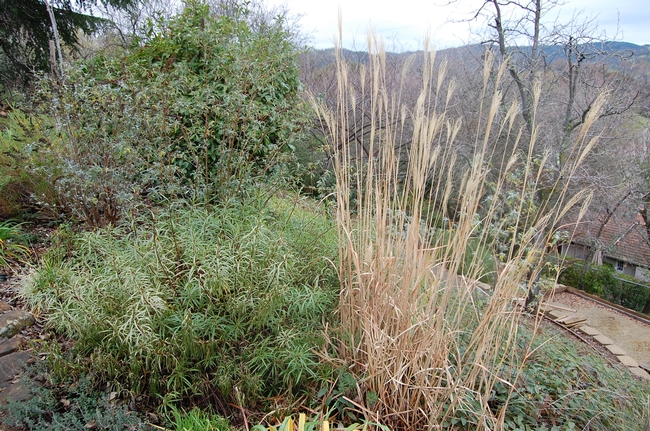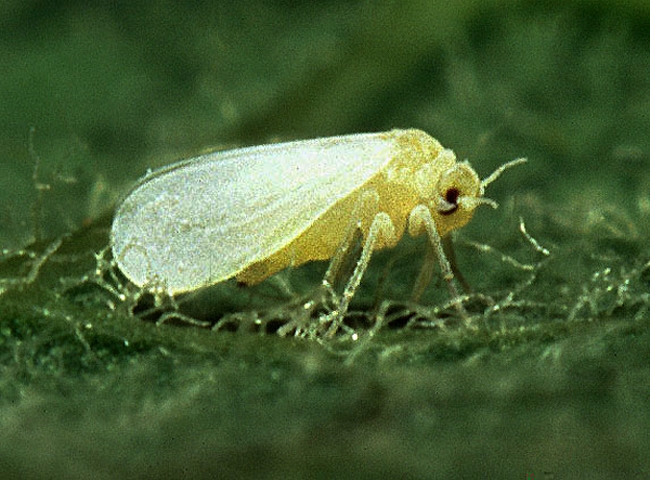UC Blogs
A She-Bee on the Hebe
The yellow-faced bumble bee, Bombus vosnesenskii, is back. We spotted some overwintering queen bumble bees gathering nectar on a hebe bush last...

Queen bumble bee nectaring a hebe at the Berkeley marina. (Photo by Kathy Keatley Garvey)

Queen bumble bee is aglow in the afternoon sun. (Photo by Kathy Keatley Garvey)

Distinguishing yellow stripe on the lower abdomen is barely visible. (Photo by Kathy Keatley Garvey)
'Tis time for the Big Chop
Rose fanciers know to prune their bloomers in late January or early February. I am not a fancier of roses, and thus do not have to worry myself with that chore. However, I do have a yard filled with California and Mediterranean native plants — and dozens of meadow grasses — that require some attention right about now.
Haircuts all around? You betcha.
Our back yard landscaping is not labor-intensive, but the Big Chop, as we call it, does take several days to complete. It’s multifunctional, really. It allows us to clean up around all the plantings, raking up (often by hand) the last of the fallen leaves. This cuts down on the hiding places that insects will find once the weather warms. It also makes the plantings look so much tidier; the yard looks newly planted, really.
We must start the Big Chop with an empty green waste toter, and maybe even pirate a neighbor’s for backup. Then the loppers come out, and the cutting begins. The butterfly bushes come down, from 7 feet tall to just 8-10 inches. Most of the salvias will also decrease in size by a third or so. The penstemons require a little less trimming, but a cleanup they will get. The catmint practically disappears, leaving just an inch or two of woody stems bristling above the soil line.
But those meadow grasses … they’re still looking pretty, especially the tall, billowy zebra grasses (Miscanthus sinensis 'Zebrinus'). They’ve faded to a bright gold, and their broomlike heads sway in the wind. I think I’ll save them for the last cut.
Are any of you prepping for a Big Chop of your own? Best of luck! May your backs not ache too much by the time you’re done.

The gold color of the now-dormant zebra grass makes it a standout. But it will soon fall during the Big Chop, as will the butterfly bushes to the left. Photo by Kathy Thomas-Rico
The U.S. is running out of farmworkers
No matter what happens with immigration reform, the United States will likely suffer a shortage of farm labor in coming decades, reported the Washington Post. The story was based on a study titled "The End of Farm Labor Abundance" by Edward Taylor, professor in the Department of Agriculture and Resource Economics at UC Davis, UC graduate student Diane Charlton and Antonio Yúnez-Naude, professor in the Center for Economic Studies at El Colegio de Mexico in Mexico City.
“It’s a simple story,” Taylor said. ”By the mid-twentieth century, Americans stopped doing farm work. And we were only able to avoid a farm-labor crisis by bringing in workers from a nearby country that was at an earlier stage of development. Now that era is coming to an end.”
Since it is unlikely that another labor pool can be found, and also unlikely that American demand for fresh fruit, vegetables and nuts will decline, farmers could turn in greater numbers to mechanical options, such as shake-and-catch harvesting machines, the study said.

Mechanical harvesting of cling peaches.
Unseen dangers are lurking in your couch
Dan Morain’s opinion piece on California Technical Bulletin 117 in the Sacramento Bee last Sunday has most of the facts we need to learn about our toxic couches. Drafted in the 1970s to mandate the fire protection for household furnishings, the bulletin was intended to save lives. That was in a naïve era, before methods could measure fire retardants in women and children or correlate their accumulation over years in our bodies to lack of attention, poor motor skills and low IQ in our children.
Studies have linked flame retardants to diabetes, cancer, hormone disruption and memory loss. UC researchers made some of these discoveries. Over years, several compounds were banned and others were introduced, usually from the same class of chemicals that resulted in new chemical exposures.
UC Berkeley Professor Brenda Eskenazi and her coauthors measured fire retardants in 300 pregnant women and their children at 7 years of age, and correlated them with low scores for neurological development. At UC San Francisco, Tracey Woodruff measured flame retardants in pregnant women and found levels twice as high in California women than those living elsewhere. These substances accumulate and persist in some body tissues for up to 12 years.
Policymakers and scientists agree that Technical Bulletin 117 needs reform, since it requires the highest levels of flame retardant in the nation and perhaps the world, as high as 5 percent of the weight of the foam. Researchers who tested dust in California homes found that new couches were just as likely to result in dangerous levels of fire retardant dust as old furniture. If I were to look for a retardant-free couch tomorrow, I would have a difficult time finding one. Nor would I be able to determine which furnishings to avoid, since the chemical content of these items is considered a trade secret.
But my precautionary dilemma is not as troubling for me as it is for the UC hospitals that continually expand to serve our communities. They also purchase new furniture with flame retardants, including crib mattresses for their most vulnerable patients. Practice Greenhealth and the Healthy Hospital Initiative promote the greening of hospitals and grapple nationwide with regulations that prevent members from removing toxins with potential harm to patients and staff. The retardant manufacturing companies have pushed back aggressively after four decades of public policy became their principal market strategy.
Governor Brown has asked state agencies to re-examine the benefits of flame retardants against their long-term costs. Until they can agree on a solution that first, does no harm, I will have an uneasy relationship with my couch.
Who's Who in the Bemisia Zoo
It's a catchy title: "Unraveling the Complex: Who's Who in the Bemisia Zoo?" Paul de Barro, a senior principal research scientist at CSIRO Ecosystem...

Silverleaf whitefly (Bemisia tabaci). Photo by Scott Baurer, USDA.


